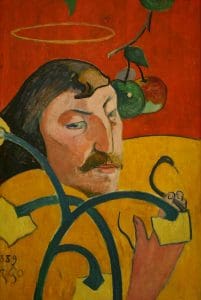Like his contemporary, Van Gogh, Paul Gauguin saw little appreciation for his artistic genius during his lifetime. In death, he is seen as one of the leading artists in Impressionist, Symbolist and Primitivism styles during the 19th century. His works have also been listed as inspiration for many Modernist artists of the 20th century such as Pablo Picasso and Henri Matisse.
Gauguin was born on June 7th, 1848 in Paris, the same year political upheaval began to cause unrest. In 1850 Paul and his family fled France for Peru, where his mother’s family held significant political status. Unfortunately for Paul, his idyllic, privileged life in Peru was ended following the Peruvian Civil War in 1854. His mother and siblings once again fled, this time back to France.
In 1873 Gauguin began painting in his free time while working as a stockbroker. During this early period his works were shown in a handful of Impressionist art shows and Gaugin’s friendship with fellow painter Paul Cezanne began around this time. In the summer of 1886 he attended an artist’s colony in Pont-Aven in Brittany where he would me a handful of artists who would join him in his adventures in Panama and Martinique.
As Gaugin and society began to move away from the Impressionist style of painting. Gaugin’s style moved to a heavier style with bold forms and dark contours known as Cloisonnism. While Cloisonnism has similarities to the expressionist movement that would eventually succeed it, its color palette kept truer to Impressionist standards. Around 1887 Gauguin made a trip across the ocean to Panama with fellow artist friend that he met at Brittany, Charles Laval. On his way back home to Europe he spontaneously decided to get off the returning boat on the Caribbean island of Martinique. There on the island, Gaugin truly came into his own style, heavily inspired by the art and culture of the indigenous inhabitants of the island. Before leaving for Europe once more, Gaugin finished 11 paintings during his stay on Martinique.
In 1890 Gaugin made his first trip to Tahiti, the island nation that would forever hold a special place in his heart and his works. One of his most famous works from this visit was La Orana Maria (Ave Maria), which depicted two Polynesian figures approaching the Madonna and Child who are Polynesian in clothing and appearance. He would briefly return to France but would return to Polynesia a 2nd time and stay till his death in 1903.
While Gaugin’s personality, personal life and even his artwork is controversial and divisive at times, his talent and ingenuity cannot be denied. While Gaugin died in obscurity, his art, particularly his Tahitian primitivism paintings, live on in museums worldwide.
Please Note: In order to bring you new and interesting titles, Hoopla content is updated monthly, and this title may not be available in the future. To find the latest titles, please visit Hoopla.




Add a comment to: June 7th 1848: Birthday of Artist Paul Gaugin